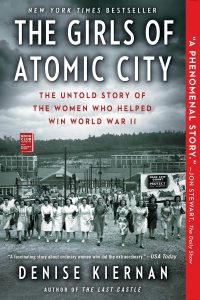The Girls of Atomic City
When My Own True Love and I decided to stop at Oak Ridge, Tennessee on our way to Atlanta, I immediately pulled Denise Kiernan’s The Girls of Atomic City: The Untold City of the Women Who Helped Win World War II out of the To-Be-Read pile where it had sat for far too long.* (Or maybe not. Perhaps books wait until their time comes.)
Kiernan explores the story of Oak Ridge through the experiences of the women who worked there, as well as those of women who played an important role in the development of nuclear fission outside of Oak Ridge. (I, for one, did not know that a German geochemist named Ida Noddack, writing in response to a paper by Enrico Fermi in 1934, was the first to postulate that the nucleus of an atom could be split by bombarding it with neutrons. Her male colleagues ignored and sometimes mocked her work.) Unlike most other works dealing with the “hidden figures” of science,** Kiernan does not limit her story to the women scientists, mathematicians and engineers who worked for the Manhattan Project. She also introduces us to secretaries, the women who operated the machines which produced enriched uranium,*** and one of the Black women who worked as cleaners in the facilities. In addition to the work itself, she talks about life in the “secret city” built deep in rural Tennessee. Mud that would suck a woman’s shoes off her feet. Housing shortages and security measures. The constant warnings about not asking questions and not telling anyone about your work. Social life in a city where the average age was 27 and men outnumbered women. She describes the racial discrimination that was literally built into the new city, and one woman’s clever efforts to make her life better than the rules allowed. It felt to me like Kiernan lost briefly her focus on women as the Manhattan Project drew to an end, with the final test at Los Alamos and the actual bombing of Hiroshima, but she quickly recovered.
The structure of the book is clever. Personal experiences alternate with sections that deal with the development of the Manhattan Project outside Oak Ridge and the science behind it. (Kiernan manages to make nuclear fission comprehensible to a non-scientist.) The compartmentalization of the book is deliberate, designed to echo the way information about the work was compartmentalized, with no one knowing how their job fit into a bigger picture, or even what the bigger picture was.
The Girls of Atomic City is a wonderful choice for anyone interested in the Manhattan Project or women’s roles in World War II.
*I swore to myself that when I was finished writing my book about Sigrid Schultz I was going to read some of the many non-fiction books I own that are not about World War II in general and women in World War II in particular. So far, that has not happened.
**How did we express this idea before Margot Lee Shetterly’s book?
***Now known as “calutron girls,” after the machines they operated, they were the Manhattan Project’s equivalent of Rosie the Riveter. Most of calutron cubicle operators were women from the middle south with a high school education. They worked eight hour days, in front of panels that allowed them to monitor the conditions that produced enriched uranium, though they did not know what the machines did.





